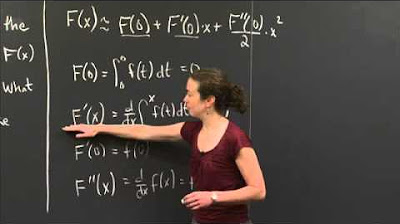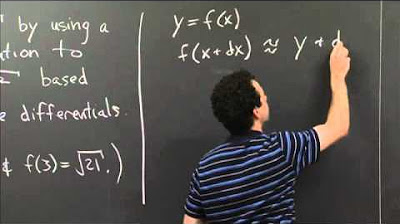Quadratic Approximation | MIT 18.01SC Single Variable Calculus, Fall 2010
TLDRIn this educational video, Joel Lewis introduces the concept of quadratic approximation, using the function f(x) = e^(x + x^2) as an example. He demonstrates two methods to find the approximation near x=0. The first method involves calculating the function's first and second derivatives at x=0 and applying them to the quadratic formula. The second method cleverly rewrites the function as a product of exponentials and applies known quadratic approximations. Both approaches yield the same result, Q(x) = 1 + x + 3x^2/2, reinforcing the concept and providing versatile tools for students.
Takeaways
- 📚 The lecture is focused on quadratic approximation, a mathematical concept used to approximate complex functions around a specific point.
- 🔍 The example given is to find the quadratic approximation of the function f(x) = e^(x + x^2) near x = 0.
- 📝 The formula for the quadratic approximation of a function f near a point is f(0) + f'(0)x + (f''(0)/2)x^2.
- 📈 The first step in finding the quadratic approximation is to calculate the first and second derivatives of the function.
- 🧩 The first derivative of f(x) is found using the chain rule and is e^(x + x^2)(2x + 1).
- 🔑 The second derivative is calculated using the product rule and results in 4x^2 + 4x + 3 times e^(x + x^2).
- 🔢 To apply the quadratic approximation formula, the values of the function and its derivatives at x = 0 are needed.
- 📌 The function value f(0) is 1, f'(0) is also 1, and f''(0) is 3, which are plugged into the quadratic approximation formula.
- 📝 The resulting quadratic approximation for the given function is Q(x) = 1 + x + (3/2)x^2.
- 🌟 An alternative method is presented by rewriting the function as a product of exponentials and using known quadratic approximations for e^x and e^(x^2).
- 📐 The quadratic approximations for e^x and e^(x^2) are 1 + x + x^2/2 and 1 + x^2, respectively.
- 📚 By multiplying the quadratic approximations of the two parts and simplifying, the same result Q(x) = 1 + x + (3/2)x^2 is obtained, confirming the correctness of the method.
Q & A
What is the main topic of the lecture?
-The main topic of the lecture is quadratic approximation, specifically focusing on the function f(x) = e^(x + x^2) near x = 0.
What is the formula for quadratic approximation in terms of derivatives?
-The formula for quadratic approximation is Q(x) = f(0) + f'(0)x + (f''(0)/2)x^2.
What are the steps to find the first derivative of the given function using the chain rule?
-The first derivative is found by applying the chain rule to e^(x + x^2), resulting in (2x + 1)e^(x + x^2).
How is the second derivative of the function calculated?
-The second derivative is calculated by applying the product rule to the first derivative, resulting in (4x^2 + 4x + 3)e^(x + x^2).
What are the values of the function and its derivatives at x = 0?
-At x = 0, f(0) = 1, f'(0) = 1, and f''(0) = 3.
What is the quadratic approximation of the function f(x) near x = 0?
-The quadratic approximation of the function is Q(x) = 1 + x + (3/2)x^2.
What alternative method is presented for finding the quadratic approximation?
-The alternative method involves rewriting the function as a product of e^x and e^(x^2) and then finding the quadratic approximations of each separately.
What is the quadratic approximation of e^x?
-The quadratic approximation of e^x is 1 + x + x^2/2.
What is the quadratic approximation of e^(x^2)?
-The quadratic approximation of e^(x^2) is 1 + x^2.
How is the quadratic approximation of the product of two functions found?
-The quadratic approximation of the product of two functions is found by multiplying the individual quadratic approximations of each function.
What is the final result when using the alternative method to find the quadratic approximation?
-The final result using the alternative method is the same as the first method, Q(x) = 1 + x + (3/2)x^2.
Outlines
📚 Introduction to Quadratic Approximation
In this first paragraph, Joel Lewis introduces the concept of quadratic approximation, specifically focusing on the function f(x) = e^(x + x^2) near x = 0. He encourages viewers to pause the video to work through the problem independently before returning to compare solutions. The paragraph sets the stage for a detailed explanation of the quadratic approximation process using derivatives.
🔍 Deriving the Quadratic Approximation Formula
This paragraph delves into the mathematical process of finding the quadratic approximation of the given function. Joel explains the use of the formula involving the function's value and its first and second derivatives at x = 0. He demonstrates the application of the chain rule to find the first derivative and the product rule for the second derivative. After calculating the derivatives, he substitutes the values at x = 0 into the quadratic approximation formula, resulting in Q(x) = 1 + x + (3/2)x^2.
📈 Alternative Method Using Exponential Properties
In the third paragraph, Joel presents an alternative approach to finding the quadratic approximation by leveraging the properties of exponential functions. He suggests rewriting the function as the product of e^x and e^(x^2) and then using the quadratic approximations of each part separately. He references a previous lecture or recitation where the quadratic approximations for e^x and e^(x^2) were established as 1 + x + x^2/2 and 1 + x^2, respectively. By multiplying these approximations and simplifying, he arrives at the same quadratic approximation Q(x) = 1 + x + (3/2)x^2, thus validating the result obtained through the derivative method.
Mindmap
Keywords
💡Quadratic Approximation
💡Derivatives
💡Chain Rule
💡Product Rule
💡Exponential Function
💡Function Value
💡Quadratic Function
💡Recitation
💡Christine's Recitation Video
💡Composite Function
💡Differentiation
Highlights
Introduction to quadratic approximation and starting the example problem.
Quadratic approximation formula using function derivatives.
Application of the chain rule to find the first derivative of the function.
Using the product rule for the second derivative calculation.
Plugging in the derivatives' values at x=0 into the quadratic approximation formula.
Calculating the function value, first and second derivatives at x=0.
Deriving the quadratic approximation Q(x) = 1 + x + (3/2)x^2.
Alternative method by rewriting the function using properties of the exponential function.
Finding quadratic approximations for each part of the rewritten function separately.
Multiplying the quadratic approximations of each part together.
Dropping higher degree terms to get the final quadratic approximation.
Verifying the result using two different methods, confirming the same answer.
Importance of understanding multiple methods for solving problems in calculus.
The exponential function's properties simplify the process of finding quadratic approximations.
Combining quadratic approximations of separate functions to find the overall approximation.
Practical demonstration of the quadratic approximation process in a step-by-step manner.
Encouragement for students to verify the quadratic approximations themselves.
Final confirmation of the quadratic approximation Q(x) = 1 + x + (3/2)x^2 using both methods.
Transcripts
Browse More Related Video

Quadratic approximation example

Second fundamental theorem and quadratic approximation | MIT 18.01SC Single Variable Calculus

How To Solve Quadratic Equations By Factoring - Quick & Simple! | Algebra Online Course

Area between curves with multiple boundaries

Linear approx. with differentials | MIT 18.01SC Single Variable Calculus, Fall 2010

Average Value of a Function
5.0 / 5 (0 votes)
Thanks for rating: